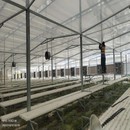Greenhouse film refers to a special plastic film used for facility agricultural production and construction. Its light transmittance, heat preservation, tensile strength and aging resistance are better than ordinary agricultural film. It is of great significance to the growth, increase in production and income of greenhouse crops
1. Agent bonding method. Mainly use vinyl chloride resin plastic glue to bond and repair polyvinyl chloride film, polyethylene film can be repaired with polyurethane adhesive, and sometimes it can be ironed with a small hot steel saw blade.
2. Mud sticking method. In the process of using the greenhouse film, if there are small damages such as scratches or wrinkles, you can cut a piece of plastic and paste the mud water on the damaged place.
3. Hot bonding method. First prepare a straight and smooth wooden strip as a backing board, nail the thin iron window screen, and fix it on the long bench. In order to prevent the plastic from being damaged during soldering, use a plane to flatten the side of the wooden strip and make it smoother. Plane. Align the edges of the two films to be bonded on the wooden strips and overlap each other about 4-5 cm. It is operated by 3-4 people at the same time, two people are responsible for the "sew" on both sides of the wooden strips, and the third person puts a piece of kraft paper or 8-10 cm wide and 1.2-1.5 meters long on the stitched film. After covering the old newspaper strip, use a preheated electric iron to run one end of the wooden strip, and use appropriate pressure based on experience to slowly push it to the other end. The heat, downward pressure, and advancing speed of the electric iron used should be such that the two films under the paper will soften and stick together to a certain extent after being heated, and then peel off the paper strips and stick them together. One piece of film is pulled to the other end of the wooden strip, and then the next piece is repeatedly bonded, cyclically, until the film is connected to the required length.
Among them, the temperature of the electric iron should be mastered when bonding the film. The suitable temperature for bonding the polyethylene film is 100-110°C, and that of polyvinyl chloride is 120-130°C. If the temperature is low, the adhesion will not be strong, and cracks will easily appear later, and the temperature will be too high. High, easy to melt the film, holes or film thinning will appear at the joints.
The pressure used and the moving speed of the electric iron should be well matched with the temperature. When the temperature is high, the pressure should be small and the moving speed should be fast. When the temperature is low, the pressure should be large and the moving speed should be slowed down. When oily stains appear on the pad of paper, it means that the temperature is too high and the plastic has melted. At this time, the paper cannot be removed immediately. It should be cooled for a while, and then taken when the paper is not hot, so that it can be better Ensure the bonding quality.










